The end of work and the end of mass affluence: welcome to The Last Christmas in America (TLCIA).
As unemployment rose toward 10%, the January 1975 cover of Rampartsmagazine blared: The End of Affluence: The Last Christmas in America. (TLCIA)
The government responded quickly to unemployment, high inflation and rising budget deficits: it started manipulating data to mask the politically inconvenient realities of rising inflation, unemployment and deficits by playing switcheroo with Social Security Trust Funds, inflation data, etc.--games it continues to play to cloak reality from the media-numbed public.
The Bear market, and thus the "real" recession, lasted 16 years: from 1966 to 1982. Now statistics are echoing that last great recession: rising prices for essentials, systemically high unemployment and stagnant wages.
We all know the 16-year recession/malaise had a "happy ending": huge new oil fields were discovered in Alaska, the North Sea, West Africa and elsewhere, ushering in a renewed era of cheap, abundant petroleum. President Reagan "saved" Social Security for a generation by raising contributions paid by employer and employees, and he heralded a "lower taxes, higher permanent deficits" ideology that is now accepted as the norm: deficits don't matter, even when they reach the trillions, because our good friends the Gulf Oil Exporters and Asian exporters will buy all our debt forever and ever, keeping interest low forever and ever.
(And if they drop the ball, then the Federal Reserve will print money and buy the Treasury bonds. Sweet! We don't need any external buyers, just the Federal Reserve.)
Then the U.S. created and launched two revolutionary technologies which both created new wealth around the globe: the personal computer (microprocessor and cheap RAM) and the Internet (TCP/IP, Ethernet, and the commercialization of Tim Berners-Lee's World Wide Web with free browsers) spawning the generation-long boom of the 1980s and 90s.
But when the wheels fell off that boom in 2000, the U.S. did not create a new engine of wealth: it opted instead for a devilishly insidious simulacrum of wealth: debt which rose at an exponential rate throughout the economy.
Borrowed money and phony financial legerdemain (mortgage-backed securities, derivatives based on the MBS, etc. etc.) from 2000-2007 created what I have termed a "bogus prosperity": no actual new wealth was created, only a brief and doomed bubble of debt-based housing valuations was inflated which followed the classic model set down by the Tulip Craze in Holland hundreds of years ago: insane boom, crushing bust.
We have to revisit the early 1970s for a reality check. In post-industrial America circa 1970, a huge surplus of food was grown by a mere 2% of the workforce. The cornucopia of manufactured goods was produced by about 20% of the workforce (hence the phrase "post-industrial"), and other than essential government services like the Armed Forces, police and the courts, the rest of society's work was either service-oriented paper-pushing relating to affluence (insurance), do-good selfless work (Peace Corps, churches) or leisure-related: entertainment, films, travel, amusement parks, stereos, clubs, etc.
This was not all fantasy. A friend of mine supported an entire house of hippies in late-60s Pittsburgh on his union steelworker job, and had plenty of money left to save for his trip to San Francisco. (As I recall, the rent for the big old house was less than $200 per month.) Hippies were the first ardent dumpster-divers/scavengers, driven not by poverty but by the idea that since that our society generated so much waste and surplus, why bother working?
As noted here many times before, the purchasing power of American workers' wages reached a plateau around 1973 and has been declining ever since.
One key point which is usually overlooked when comparing "The Last Christmas in America" circa 1974 and TLCIA circa 2012: the wealth distribution in the U.S. was much flatter then. CEOs of financial institutions did not earn $10 million each; there were no hedge funds with chiefs pulling down $600 million each (yes, that was the average "compensation" for the top ten fund managers at the hedgies' glorious peak), and even minimum wage ($1.60/hour in the late 60s, I know because my wage stub recorded it) bought far more goods (purchasing power) then than minimum wage does now.
Not only was gasoline cheap, but housing was far and away cheaper than it is today. Just about any G.I./Vet could buy a house with his/her V.A. benefits (3% down), and anyone else could scrimp and save for a few years and then buy a house for 2 or 3 times their annual wage at an interest rate around 6%.
Even in the the most expensive city in the U.S. in terms of cost-of-living, Honolulu, I was able to rent an old studio apartment in 1973 for $120/month--$525 in today's dollars. My tuition and student fees at the University of Hawaii per semester in 1971-75 was $117--$514 in today's dollars. Can you find an apartment in a high-cost city for $500 and go to a four-year state university for $500/semester (not including books of course)? No. Was the state or Federal government running stupendous deficits to provide this education? No.
Meanwhile, in TLCIA circa 2012, obscene "compensation packages" are defended as "free enterprise." Well, what did we have in 1973? Unfree enterprise? Amidst all the ideologically convenient defenses of heavily skewed "compensation," we have to admit that the dream of affluence combined with leisure was based on the presumption of society's wealth being distributed somewhat evenly, not by a Communist central state but by the "free enterprise" system and modest common-sense government regulation (limited work hours, overtime, minimum wage, etc.) which protected employees from the excessive exploitation of the late 19th century and early 20th century Monopoly Capitalists.
Now we face a future which might well be called the End of Work for up to a third of the current workforce. Since agriculture employs about 2% of the workforce, industrial/factory production about 11%, essential transportation and essential government each a bit more, we have to ask: in an economy in which 70% of GDP is consumer spending, how many jobs are actually essential? How much actual wealth is being created/produced in the U.S. and sold overseas? Is giving people with Medicare coverage 13 costly and often ineffective medications and endless MRI tests actually creating wealth, or it mostly squandering it?
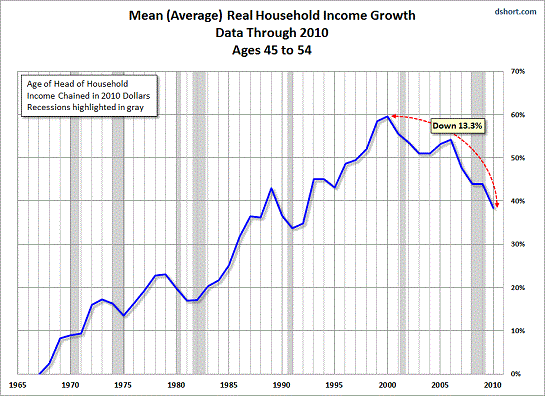
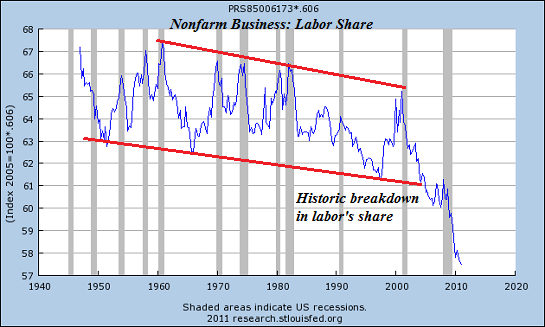
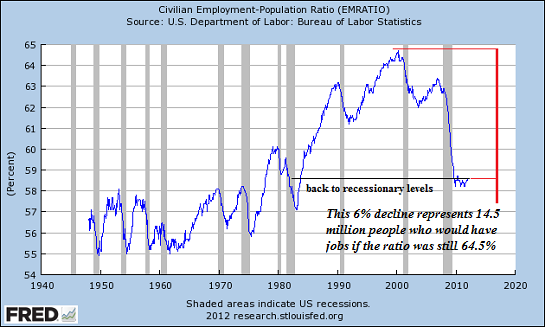
We might also ask: how much of the consumer economy is superfluous if wage-earners shift values and decide saving is more important than consuming? How many malls, storefronts, internet retailers, restaurants, fast-food joints, etc. can a newly-frugal economy support? How many dog-walkers, derivative salespeople, nail shops, carpenters, financial planners, realtors, etc. does an economy need if the FIRE economy (finance, insurance and real estate) is shrinking?
Based on the tremendous size of the service/FIRE economy and government, I have estimated that 30 million jobs out of the current 142 million-strong workforce are superfluous (114 million full-time, 38 million part-time). Many government positions are essential: police, meat inspectors, rangers, tax collectors, meter maids, etc., but dozens of agencies could be eliminated without any visible effect on the economy except to the wage-earners who lost their jobs.
If 10 million more jobs disappear, so do all the taxes those wage-earners paid; if the 5 million homes in the pipeline go through foreclosure, the inflated property taxes the owners once paid will disappear, too. Once businesses close, it's not just wages which disappear: all the junk-fees governments levy disappear, too: the business taxes, the licensing fees, the permits, transaction fees, etc.
Does anyone think all these taxes and levies can fall and government employment will be funded by some other source? Yes, the Federal government can borrow money for a few more years at low interest rates; but soon, the surplus money which has piled up in exporters' accounts will be gone, and the endless borrowed trillions will actually start costing real money--money that will be diverted from government employment to pay the interest on all that wonderful debt everyone loved when they got a piece of it.
So how does a society deal with the End of Work when it also means The End of Affluence, even for many of those with jobs? How does government deal with declining tax revenues and rising interest rates?
The death throes of the debt-based consumerist lifestyle are already visible beneath the glossy propaganda of "rising revenues this Christmas season."
The Fed is desperately attempting to re-inflate the debt bubble by lowering interest and mortgage rates and buying up all sorts of semi-toxic/impaired debt.What the Fed dreads is the reality we all feel and see: fear of the future due to diminished wealth and shaky incomes. If your assets have been slashed, you feel poorer because you are poorer. Borrowing more at any interest rate will not make anyone feel wealthier.
People who fear their income may plummet due to layoffs or their hours being cut are not in the euphoric mood to borrow more, and banks which cannot dare to lose more money loaning to people who will default have cut off credit to millions of previously rabid consumers of debt.
And let's not forget that much of what is purchased in this frenzy is needless, superfluous crap. My wife saves the most egregiously gift-buying-frenzy advertising circulars, and one from Bed, Bath & Beyond caught my eye.
There is no difference between this "1001 Best Gifts" from BB&B and a parody of consumerist excess. Hmm, how about an "executive standing valet" rack of wood and plastic for $99.99.
To make this poor-quality contraption, a forest somewhere in a Third-World kleptocracy was cut down and precious, irreplaceable oil was burned shipping the lumber to China and from that factory to the U.S. across 6,000 miles of Pacific Ocean.
We know this spindly piece of garbage will break in a matter of days, weeks or maybe if the owner is especially careful, months; then the legs will break loose of the base, the towel bar will pull out, etc. and the "we cut down a priceless rain forest to make this" piece of human handiwork will be put on the curb where a diesel-burning garbage truck will haul it to the landfill along with all the spoiled food Americans throw out.
The 16-bottle wine cellar/cooler from China (labeled Cuisinart for your consuming pleasure) for $199.99 might come in handy storing something once it's unplugged--but a cardboard box will probably do just as well.
I for one will not mourn the last Christmas in America. Good riddance to the flaunting of borrowed money and the heedless, desperate purchase of valueless "goods" as gifts for an insolvent nation awash in too much of everything but common sense, integrity, gratitude, accountability and healthy living.
Things are falling apart--that is obvious. But why are they falling apart? The reasons are complex and global. Our economy and society have structural problems that cannot be solved by adding debt to debt. We are becoming poorer, not just from financial over-reach, but from fundamental forces that are not easy to identify or understand. We will cover the five core reasons why things are falling apart:
 1. Debt and financialization
1. Debt and financialization
2. Crony capitalism and the elimination of accountability
3. Diminishing returns
4. Centralization
5. Technological, financial and demographic changes in our economyComplex systems weakened by diminishing returns collapse under their own weight and are replaced by systems that are simpler, faster and affordable. If we cling to the old ways, our system will disintegrate. If we want sustainable prosperity rather than collapse, we must embrace a new model that is Decentralized, Adaptive, Transparent and Accountable (DATA).
We are not powerless. Not accepting responsibility and being powerless are two sides of the same coin: once we accept responsibility, we become powerful.
10% discount on the Kindle edition: $8.95(retail $9.95) print edition: $24 on Amazon.com
To receive a 20% discount on the print edition: $19.20 (retail $24), follow the link, open a Createspace account and enter discount code SJRGPLAB. (This is the only way I can offer a discount.)
| Thank you, Santiago A. ($5/month), for your splendidly generous subscription to this site -- I am greatly honored by your support and readership. | | Thank you, Jaebin L. ($25), for your marvelously generous contribution to this site --I am greatly honored by your support and readership. |
-->
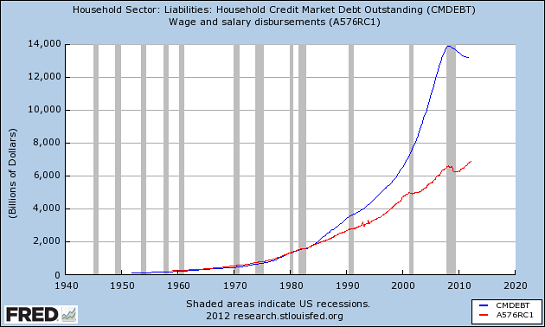
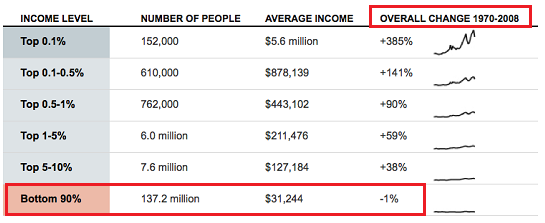



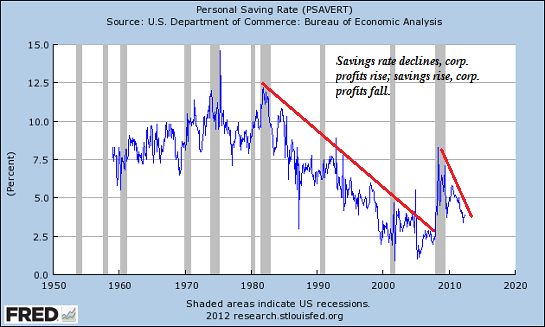
 1. Debt and financialization
1. Debt and financialization


























